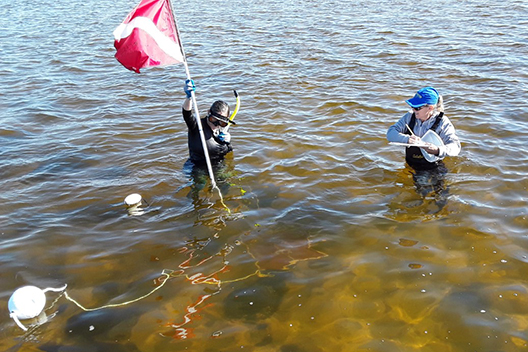Piney Point is a wastewater storage facility located in Manatee County, Florida. In late March of 2021, a tear was reported in the liner of the largest pond putting the reservoir — which contains processed water from a former phosphate facility, seawater from a Port Manatee dredge project, and stormwater — at risk of collapse. To prevent the reservoir from failing, wastewater was discharged from the ponds out of Port Manatee into Tampa Bay.
Since the beginning of the Piney Point wastewater discharge emergency, UF/IFAS and Florida Sea Grant have been working to help answer questions that the public and the media have about how the discharged wastewater might impact Tampa Bay, especially as it relates to harmful algal blooms (HABs). The wastewater contains high concentrations of nitrogen and phosphorus, which are nutrients that may feed HABs.
Drs. Lisa Krimsky, UF/IFAS Extension Florida Sea Grant Regional Specialized Agent for water resources, and Angela Collins, UF/IFAS Extension Florida Sea Grant agent for Manatee, Hillsborough and Sarasota counties, have helped develop a list of FAQs about how the discharge might impact the bay as well as a list of links for up-to-date information about the situation.
One of the potential impacts could be a bloom of macroalgae, or seaweed. This occurred after discharges from Piney Point in 2011. Multiple agencies and organizations are monitoring the bay using macroalgae monitoring protocols that UF/IFAS Extension Florida Sea Grant agent Betty Staugler developed in 2019 to monitor macroalgae in Charlotte Harbor.
This rapid response assessment for macroalgae will allow resource managers to quickly characterize conditions before a macroalgal response occurs and then track the balance between macroalgae and seagrass as they react to the nutrient-rich discharge waters. Monitoring and data compilation for the macroalgal assessment is being coordinated by the Tampa Bay Estuary Program.

FAQs
How do algae blooms happen in Florida?
Algae are naturally occurring throughout Florida waters. Nutrients in abundance feed these algae, which may lead to blooms. Some algae species are toxic and are called Harmful Algal Blooms (HABs).
What is in the water contained in the Piney Point ponds?
The wastewater is a combination of seawater from a former Port Manatee dredge project, processed water from the phosphate facility, and stormwater/rainwater. There are high concentrations of nitrogen and phosphorus in the wastewater, which are nutrients that may feed HABs.
Who is monitoring the Piney Point discharge?
FDEP is the lead agency charged with sampling water quality and addressing concerns regarding the discharge. General water chemistry and a suite of parameters, including nutrients, chlorophyll a, phytoplankton (identification and enumeration), turbidity, metals, gross alpha (a test for radioactivity in drinking water) and radium are being assessed.
Manatee, Hillsborough and Pinellas counties are involved in the response and have been monitoring ambient water quality.
Algal samples will be collected at a broad distribution of sites, and FWC-FWRI and FDEP will coordinate algal identification.
Multiple government, research and academic entities are contributing to the monitoring efforts.
Will it cause a red tide event?
No, this will not necessarily cause a red tide. Elevated nutrients could enhance conditions for bloom-forming species, including red tide. Red tide would have to be in the vicinity of Tampa Bay for a red tide bloom to occur.
There are many factors that contribute to a red tide bloom. Know your current red tide bloom status and bloom forecast predictions.
Could there be other algal species that benefit from nutrients in this discharge and become a nuisance?
Macro algae (large seaweed-like algae) have bloomed after previous discharges.
Will this affect the distribution of fish and other animals?
We do not know how this will impact the fish community. Multiple entities (including FWC-FWRI and Mote Marine Lab) are actively monitoring distribution of fishes and marine mammals in the discharge area
Is drinking water safe?
Municipalities’ water is a closed system and safe. There is no current reason to suspect well water is compromised. If you have specific concerns, contact your local department of health.
What about the safety of seafood?
There is no reason to suspect that seafood is unsafe. Multiple entities evaluate water and seafood quality on a regular basis. State agencies would close an area if it was deemed unsafe.
Standard advice still applies: If there are obvious signs of a fish kill present, don’t fish or collect shellfish there. One resource to consider is Florida Department of Agriculture and Consumer Services’ Shellfish Harvesting Area Maps.
Can I report unusual observations to my local UF/IFAS Extension office?
Yes! Find your local office.
For more information and updates, consider these resources:
311
311 is a county-level urgent issues resource. Citizens can call 311 with any urgent needs or questions.
Tampa Bay Estuary Program
Website
TBEP Pine Point Environmental Monitoring Dashboard
Florida Department of Environmental Protection
Piney Point Regional Notification
Manatee County
Piney Point Updates
Media Inquiries
Interviews with the following experts can be coordinated through Brad Buck at bradbuck@ufl.edu.
Lisa Krimsky
Regional specialized agent for water resources, UF/IFAS Extension Florida Sea Grant
Based in Fort Pierce, FL, but covering South Florida
Mary Lusk
Assistant professor, soil and water sciences (specializes in urban soil and water quality)
at UF/IFAS Gulf Coast Research and Education Center in Wimauma, FL
Ashley Smyth
Assistant professor, soil and water sciences (Florida Sea Grant affiliate faculty)
At UF/IFAS Tropical Research and Education Center in Homestead, FL
Don Rainey
Regional specialized agent for water resources (terrestrial impacts), UF/IFAS Extension
Southwest Florida, based in Plant City
Agencies requiring additional information can contact Lisa Krimsky at lkrimsky@ufl.edu.
Updated 15 April 2021